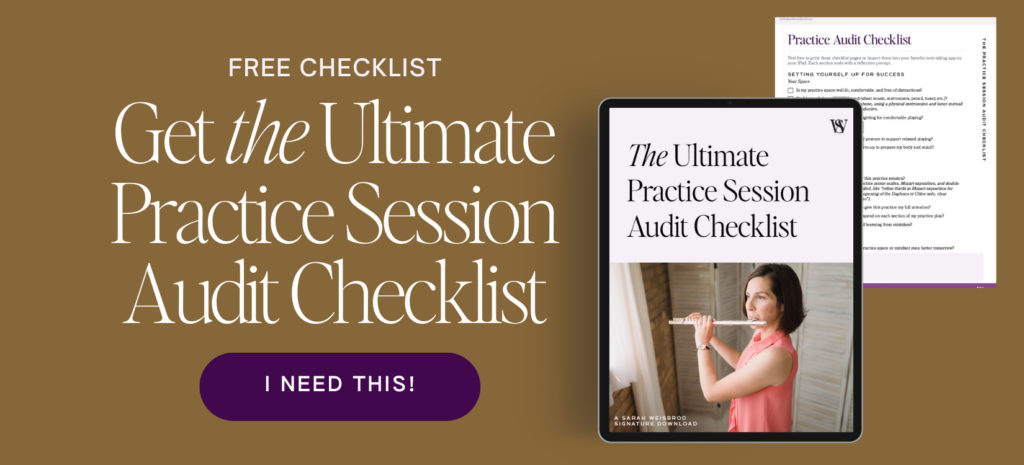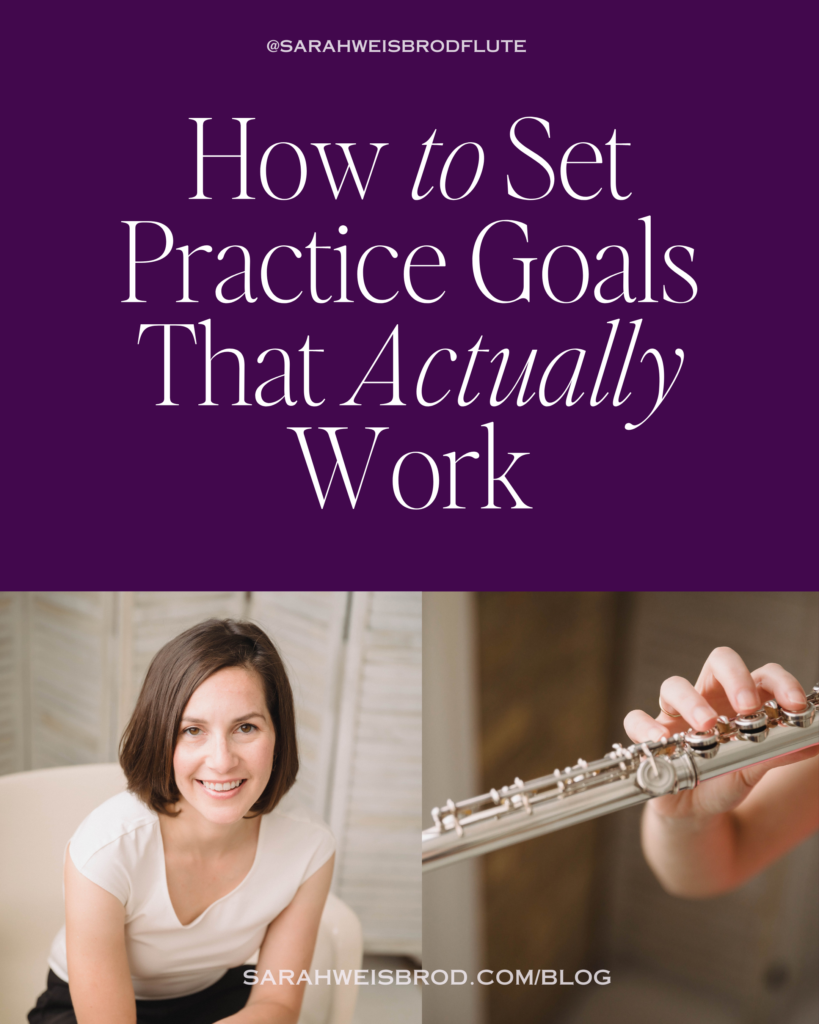If you’ve ever walked out of a practice session wondering what you actually accomplished… welcome to the club.
I used to spend hours thinking I was practicing diligently and fulfilling my practice goals only to feel frustrated and wonder where all my time went.
I filled practice journals with goals, but I often felt like I could never achieve them. The closer I thought I was getting, the further away I felt.
Turns out, I had the right intention of setting practice goals, but I wasn’t setting the right kind of goals that would move the needle and help me level-up my playing.
Once I learned how to create attainable practice goals, my practice sessions became more productive, my confidence grew, and I finally started seeing consistent progress.
That’s why this post is all about how to set practice goals you can actually achieve.
Let’s dive in!
BTW, if you want to make sure you never miss a beat in your practice sessions, grab your free copy of the Practice Audit Checklist. It helps you get clear on what to focus on—from tone to repertoire to mindset.

The Real Reason You’re Not Making Progress (It’s Not Discipline)
The kind of goals you create for yourself has a direct impact on your results, and multiple studies show this. I know it sounds obvious, but here’s the thing:
Most musicians were never taught how to create practice goals.
If you’re leaving the practice room feeling frustrated, it’s not because you’re lazy. Odds are, your goals are too vague, which makes it easy for you to feel like you’re not making progress.
Goals like:
- Play with a clearer tone
- Fix the tricky passage in the exposition of my Mozart concerto
- Improve double-tonguing in the Mendelssohn Scherzo
are difficult to measure and quantify. What does it mean to achieve these goals? What does it mean to play with a clearer tone? How do you know when you’ve “fixed” the tricky passage? When does one meet the criteria for “improving double-tonguing?”
As a musician, you’re constantly improving, which means what was once acceptable a year ago may not be acceptable today.
To be successful with your practice goals, you need clearly defined goals that lead you on a path towards accomplishment.
What Effective Practice Goals Actually Look Like
You may have heard of SMART goals:
- Specific
- Measurable
- Achieveable
- Relevant
- Time-based
Understanding how to set practice goals that are specific and achievable is one of the most effective ways to get measurable results from your time in the practice room.
Let’s focus on the first three: Specific, Measurable, and Achievable.
In most practice scenarios, your goals are already relevant and time-based by nature. But your goals likely need to be fine-tuned so you can see progress and success.
Specific
Specific goals are precisely what they sound like: well-detailed, naming exactly what you’re working on.
Instead of having a vague goal of “Fix that tricky passage,” write out exactly what you want to solve.
“Clean up the articulation in measures 127-134.”
Measurable
Your goals need to be measurable. You can do this by tracking tempo, missed notes, the quality of your playing, etc. Think of it as data. What can you monitor and track for improvement?
Using the “Fix that tricky passage” goal from above, you can ensure it’s measurable by tracking the quality. Is the articulation cleaner? If you’re not sure, record yourself and analyze your playing.
It’s also important to ensure that achieving a goal doesn’t compromise another area of your playing. For example, once you get the articulation cleaner, is your tone quality still the same? Are you still playing expressively with a crisp articulation?
Achievable
You want to make sure that the practice goals you set are achievable. Yes, your overall goal is likely to learn your repertoire, but that’s a long-term goal, not a practice goal.
Take double-tonguing, for example. If you want to be able to double-tongue at ♩= 160, your practice goal for the day may be to increase your double-tonguing by six clicks. Or maybe you’re working on a specific section of your piece, and your goal is clarity in the syllables. Your goal may be “have clear, even articulation at ♩= 80.”
Break It Down: Why Micro-Goals Matter
Let’s take the idea of SMART goals one step further to ensure your practice goals are truly attainable during a practice session.
Think of your practice session goals as short-term goals. If the long-term goal is to learn the piece, then a practice session goal may be to isolate four measures and get them at tempo using various practice techniques.
You want your practice session goals to be achievable within the practice session itself. And they should push you without creating overwhelm. This is why micro-goals are so important.
Micro-goals are incredibly specific, making them easily measurable and achievable during your practice session.
Let’s take the examples from the beginning of the post and create micro-goals from them.
“Play with a clearer tone” becomes “Work on the legato connection between C and E-flat in my tone development etude.”
“Fix the tricky passage in the exposition of my Mozart concerto” becomes “Work on breath, tongue, place at each entry in measures 127-134 of the Mozart concerto for even coordination.”
“Improve double-tonguing in the Mendelssohn Scherzo” becomes “Increase tempo from ♩. = 60 to ♩. = 64 while playing with an even and crisp articulation.”
Your micro-goals don’t have to get you to the end result. Think of them as stepping stones along the way of a larger journey.
Celebrate the Small Wins
The best part of setting practice goals that are achievable during your practice session? It creates an instant dopamine boost.
Not only are you creating forward momentum, but you’re also increasing your confidence because you’re meeting expectations that you created.
And that matters. Because confidence doesn’t magically show up on performance day. It’s built in the tiny moments when you keep promises to yourself.
So when you move up 2 metronome clicks? That’s a win. When you clean up a messy shift? That’s progress.
The more you acknowledge those small victories, the more resilient and motivated you become over time.
Bonus Tip: Track Your Progress
One of the most effective ways to track your progress is by keeping a practice journal.
You can log and monitor things like:
- Tempo markings
- What you worked on
- What improved
- What needs more time
Your practice journal—whether physical or digital—doesn’t need to be super complicated.
Plus, by tracking your goals you have a record of a your growth. So, on days when you feel like you’re not making progress, you can look back and see how far you’ve come.
The next time you’re getting ready to practice, take a moment and use this system to create achieveable practice goals.
Remember, it’s about creating goals that are specific, measure, and attainable during your practice session.
And when you create micro-goals you’re setting yourself up for success and increased confidence.
If you need some extra help with creating an effective practice session, check out this post. It’s an oldie, but a goodie.
Want a clearer picture of what’s working (and what’s not) in your practice?
➡️Download the free Practice Audit Checklist.⬅️ It walks you through how to evaluate your current habits, identify common practice mistakes, and create goals that help you show up with purpose every time you open your case.


+ show Comments
- Hide Comments
add a comment